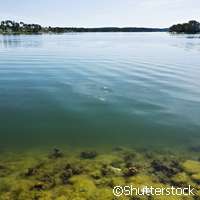Further proof that rising temperatures lead to more algal blooms

Researchers from Denmark, Germany, the Netherlands, Norway and Sweden have shown that for the Baltic ecosystem, further global warming could lead to the development of more blue-green algal blooms amid the onset of lower oxygen conditions.
Algal blooms are already a huge problem in many parts of the Baltic, linked to the increase in large areas characterized by deoxygenated conditions, void of any life forms. In very high densities, algal blooms can discolour the water and outcompete, poison or asphyxiate other life forms in the sea.
Over the past few years scientists have noticed these massive blue-green algal blooms, or cyanobacteria, increase in number, in part because of an increased supply of nutrients from intensive agriculture, primarily phosphorus and nitrogen. But temperature changes have also been thought to be a key factor in the presence or otherwise of the blooms, and now the team, led by Karoline Kabel and Matthias Moros from the Leibniz Institute for Baltic Sea Research in Warnemünde, Germany, present new evidence to support this theory.
Writing in the journal Nature Climate Change, the scientists point to the role temperature plays in fostering the addition of the nutrients and they predict that a continued rise in temperature will only make the problem worse.
The scientists used a new method, TEX-86, to estimate past temperatures. Analyses of temperature-sensitive biological compounds found in the sediments could thus be used to quantify past temperature changes, at times before thermometers were available. The interpretation of the sedimentary information was additionally supported by the application of ecosystem models which were used to calculate the ecosystem sensitivity to a combination of temperature and nutrient concentrations in the Baltic.
'To isolate the effect of temperature, the scientists had to take their investigations back to times prior to large-scale industrialised agriculture, before increased nutrient supply became a major influence,' comments study co-author Professor Eystein Jansen from Bjerknes Centre for Climate Research in Bergen, Norway.
By using sediment cores covering the last 1,000 years of sedimentation in the Baltic, they were able to unravel warm periods in the past that were also characterized by algal blooms and low oxygen content. The study goes back to the Medieval warm period: 1,000 to 800 years ago. In the following period, often referred to as the 'Little Ice Age', temperatures in the Baltic dropped 3-4 degrees. During this cold snap conditions in the Baltic were much healthier, until blooms and deoxygenated conditions emerged again in the 20th century.
Professor Jansen comments on the way this study combines ecosystem model simulations with studies of past climates: 'This is an exciting, pioneering work that shows the usefulness of combining studies of past natural climate variations with those occurring today and those that may unfold in the future. Much of the waters that flow along the coast of southern Norway originates in the Baltic, so the results may have implications also in a broader setting.'
Despite these predictions, in the short term it seems that the presence of algal blooms varies from area to area. Last month, researchers from the Finnish Environment Institute's (SYKE) Marine Research Centre announced that the risk of blue-green algal blooms off the coast of Finland, especially in the Gulf of Finland and around its mouth, is mainly moderate this summer, much lower in comparison to last summer. In the Gulf of Bothnia no major blooms are forecast.
However, they also noted that in the southern reaches of the Archipelago Sea and in the northern parts of the Baltic proper there is a considerable risk of algal blooms.
More information: Kabel, K., et al. 'Impact of climate change on the Baltic Sea ecosystem over the past 1,000 years', Nature Climate Change, 2012. doi:10.1038/nclimate1595
Journal information: Nature Climate Change
Provided by CORDIS

















